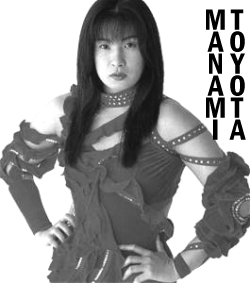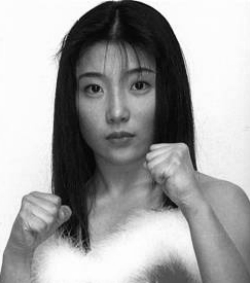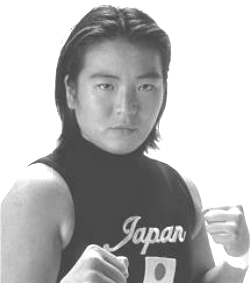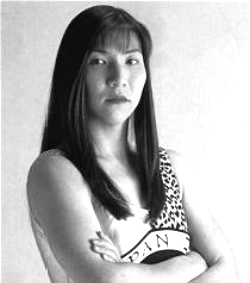Fighting Fit

Born: 7/11/69
Height: 5’4″ Weight: 139 lbs.
A viable contender for #1 babe in professional wrestling, and a leading light in the AJW federation. Possibly also the best combination of beauty and skill currently working.
Let’s clear up one preconception right away: this brand of female sport has absolutely nothing to do with mud, jelly, custard or any other semi-liquid substance. It’s even light-years removed from the things you may remember seeing on World of Sport, and GLOW is but the finger-paintings of small children in comparison. This is the nearest thing you’ll get to gladiatorial combat in the 1990’s.
But you might say, isn’t it all staged? And the obvious reply is, don’t be stupid. Of course it is.
However, let’s distinguish between “staged” and “fake”. Once you see Dynamite Kanzai wrestle, her blood streaming out in a way Peter Jackson would reject as excessively gory, or watched Yumiko Hotta kick her opponent repeatedly in the head, then you’ll know the difference. If you still have doubts, in April, rookie Emiko Kado died as a result of brain injuries incurred in the ring – and is not the first to die for her art. As “fakes” go, this would seem to be pretty convincing, if you ask me.

Born: 22/10/69
Height: 5’1″ Weight: 121 lbs.
Cuty was the first Japanese lady wrestler I ever saw, part of the series ‘263 Useful Ideas From Japan’. Recently retired, she also starred in ‘Cuty Suzuki’s Ringside Angels’ for the Sega Game Gear
Sure, they know beforehand who’s going to win, but that’s true for every Jackie Chan fight, and nobody whinges about that. It’s missing the point, like calling ‘Macbeth’ a whodunnit. To fans, the result is less important than the route by which they reach the end, though the best wrestlers will tend to ‘win’, simply because they are who the crowd wants to see. ‘Exhibition wrestling’ is probably the most accurate term, and certainly, you can’t deny the skill necessary to pull off moves when the margin for error, without seriously hurting your opponent or yourself, is so small. It’s as much spontaneous ballet as martial arts, though Jackie has the major advantage that he gets second takes, instead of having to ad-lib a continuation.
Queen of the Pain Barrier Megumi Kudo, now retired, looked like an archetypal Japanese lady, but gave more blood than most transfusion services. Regular wrestling wasn’t tough enough: she upped the ante by, for example, replacing the ropes with barbed wire. Her retirement match combined a load of these enhancements into the wrestling equivalent of a pizza with everything on. It was billed, in typically understated style, as a “No rope, 200 Volt, double hell, double barbed-wire barricade, double landmine, glass crush, electrical barbed-wire death match”. She ended up in hospital with concussion and 3rd-degree burns; more memorable than being given a gold watch, I suppose.

Born: 2/3/71
Height: 5’6″ Weight: 150 lbs.
Her trademark move is the moonsault, a backflip off the top corner turnbuckle, landing across her opponent. Toyota’s tenacity is the stuff of legend, even against far larger opponents.
Kudo was a superstar, and the top women often make as much money, if not more, outside the ring through products ranging from CDs to “Lifestyle videos” which, for example, portray the wrestlers on holiday. However, following the collapse in the Japanese economy, most leisure pursuits have suffered, and wrestling is certainly no exception: TV coverage has become limited, and shows that previously played to five-figure crowds now struggle to reach a fraction of that. As a result, the federations which run promotions have been springing up, going bankrupt and reforming at a whirlwind pace. AJW, for many years the #1, have recently endured financial trouble; they are still perhaps the strongest around, but there are also plenty of up-and-coming groups including Neo Ladies and Arsion, both of which are headed by veterans, Kyoko Inoue and Aja Kong respectively.
Kong’s name is self-descriptive: when she hits opponents off the top rope, they tend to stay hit. She represents the “blunt instrument” school of wrestlers, who concentrate on strength. This works, however, because unlike men’s wrestling, there is a huge variety of styles and forms on show – far more appealing than endless contests between steroid-bloated pretty-boys – plus the better participants have an amazing spectrum of skills, with timing and agility still required. The contrast of speed and power usually makes for a good contest; even though there are weight divisions, they are so broad as to be ineffective. But I personally feel this poses interesting questions: how do you deal with someone a hundredweight heavier than you?

Born: 22/5/76
Height: 5’0″ Weight: 123 lbs.
One of the best of the new generation, it’s on people like her that the future depends; there’s no doubting her beauty, skill and, above all, her infectious enthusiasm for the sport
There is no strict correlation between beauty and morality; at her peak, in the early 90’s, Akira Hokuto sometimes resembled a cheerleader, but it was a distinctly psychotic one, with a nasty grudge. She gave the disturbing impression that she genuinely enjoyed inflicting pain on her opponent, even when it involved a blatant disregard for her own personal safety – she had her neck broken in one bout, thanks to a miscued pile-driver. There are plenty of others whose looks belie their attitudes, though in the fluid world of Japanese wrestling, good becomes bad with baffling frequency, probably linked to the continual flux of groups, federations and organizations mentioned above. Alliances form and dissolve with the phases of the moon, before, after or even during fights. A laid-back approach to viewing is essential, together with a touching optimism that whatever happens would make sense, if only you knew Japanese.

Born 1/10/67
Height: 5’6″ Weight: 165 lbs.
Possesses a lethal right foot, used to vicious effect on opponents. A late bloomer, and also a 1998 candidate for the Japanese parliament – gives one new respect for politics.
Despite what some think – in London, all women’s wrestling was banned by the GLC – sex has little to do with it. The costumes are utilitarian and, unlike ‘Foxy Boxing’, do not “fall off”. While undeniably nice, beauty is no prerequisite for employment; physical ability and the willingness to go several extra yards in the name of entertainment clearly are far more important. Some no doubt will claim exploitation, or that it’s demeaning to women; I defy anyone to watch without acquiring deep respect for the wrestlers. It’s notable that a significant percentage of the audience is schoolgirls, and there’s a case for them being better role-models than, oh, say certain Spice-shaped persons. But regardless, it’s irrelevant, since anyone seeking role-models in the entertainment industry is very badly misguided.

Born: 9/2/69
Height: 5’5” Weight: 132 lbs.
A native of Sasebo City, Kaoru made her debut in 1986 vs. Megumi Kudo. The ‘Excalibur’ is her signature move, and it’s rare to see her in a match of below-average quality.
People round the globe are slowly discovering that the popular image of subservient Japanese cute is a shallow myth – any lingering doubts will last about five minutes into your first barbed-wire death match. I think it’s safe to say that Japanese women’s wrestling certainly has the potential to join anime and Hong Kong films as Asian imports into Western popular culture, and indeed, after a spell in the doldrums, American federations are picking up on the distaff side. Characters like Sable and Chyna are increasingly popular, albeit with any actual wrestling usually well in the background, while ‘Celebrity Deathmatch’ proved that women – or claymation versions of Monica Lewinsky and Hillary Clinton at least – and violence do mix. The Japanese model would be ideal for Granada Men & Motors, alongside their LPWA shows, or any other enterprising cable channel [Bravo have apparently screened some]. If they need a presenter, the address is at the front, and my rates are very reasonable…
Until then, it will no doubt continue at a cult level, where the informal trading of tapes and information is a throwback to the heady days of 1980’s genre fandom. Except that when Customs drool wildly over a tape labelled ‘Japanese Hardcore’, this time the laugh’s on them…